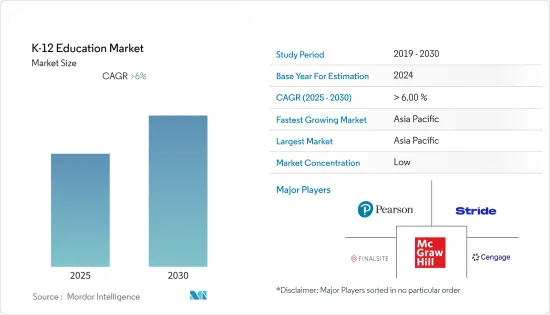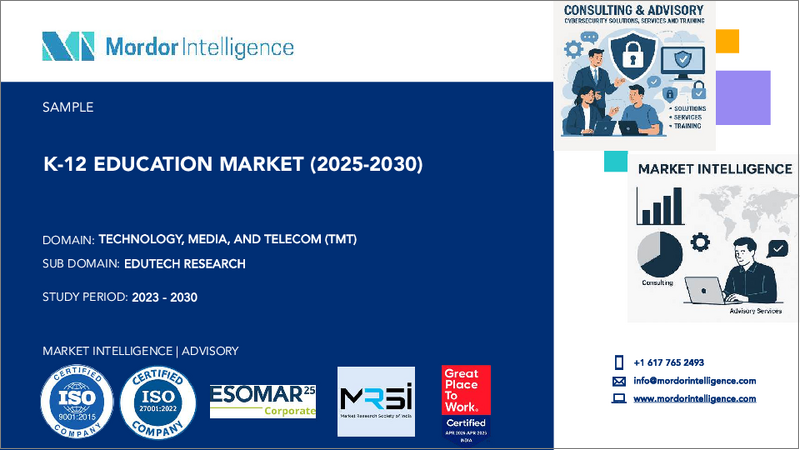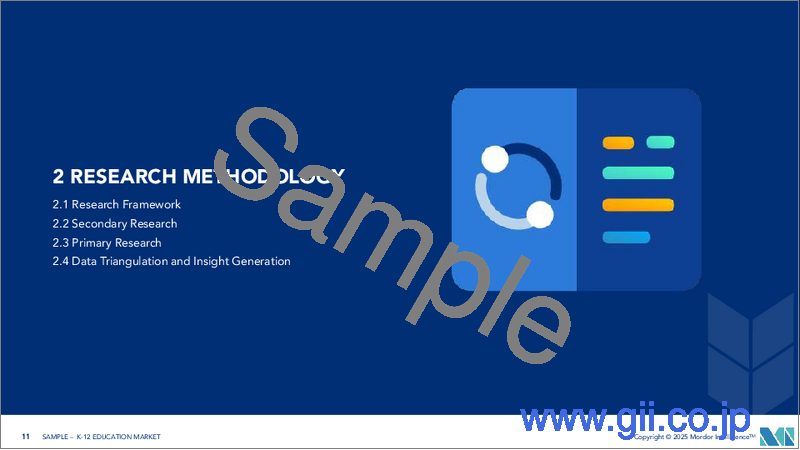|
|
市場調査レポート
商品コード
1683435
K-12教育市場-市場シェア分析、産業動向・統計、成長予測(2025年~2030年)K-12 Education - Market Share Analysis, Industry Trends & Statistics, Growth Forecasts (2025 - 2030) |
||||||
カスタマイズ可能
適宜更新あり
|
|||||||
| K-12教育市場-市場シェア分析、産業動向・統計、成長予測(2025年~2030年) |
|
出版日: 2025年03月18日
発行: Mordor Intelligence
ページ情報: 英文 179 Pages
納期: 2~3営業日
|
全表示
- 概要
- 目次
K-12教育市場は予測期間中にCAGR 6%超を記録する見込みです。

近年、K-12教育市場は堅調な成長を遂げており、中学・高校におけるオンライン学習の重要性が高まっていることが浮き彫りになっています。先進的なオンライン学習プラットフォームの導入と、公立・私立のK-12教育機関での採用拡大が、市場拡大に拍車をかけています。
技術が教育産業に浸透するにつれ、学校や大学は革新的なソリューションを統合しています。これには、AR/VRインタラクティブコンテンツ、電子書籍、認定大学が認めるオンラインコースなどが含まれます。その結果、K-12教育技術市場は飛躍的な成長を遂げようとしています。スマートラーニング」のためのモバイルデバイスの人気が高まっているのは、その携帯性と、コンテンツやソーシャルインタラクションへのアクセスのしやすさに起因しています。さらに、これらのデバイスは生徒と教師間の迅速なコミュニケーションを促進し、効率的なフィードバック収集を可能にします。最近のICT技術の進歩は、学習成果の正確な観察と測定を可能にし、市場の成長を著しく強化しています。
オンライン教育の利点は、デジタル学習ソリューションの急増を大きく後押ししています。こうした利点には、幼稚園児から高校生までの理解を助ける、強化されたビデオベースのコンテンツが含まれます。例えば、2023年9月、アメリカの大手ソフトウェア会社であるアドビは、インドの教育省と提携しました。この提携により、学校はAdobe Expressベースのカリキュラム、トレーニング、認定を受けられるようになります。2,000万人の生徒と50万人の教育者を対象とするこのイニシアチブは、K-12教育機関におけるソフトウェア主導型教育の受け入れが拡大していることを強調するもので、2027年を目標に掲げています。
K-12教育技術では、コンテンツタイプ、ユーザーインターフェース、価値提案が、若い学習者に対応するために大きく変化します。企業はまた、教師、保護者、生徒、学校管理者にとってのソフトウェアの使いやすさを優先しなければならないです。幼稚園児から12歳までの生徒がますますデジタルコンテンツに引き寄せられるにつれ、オンライン教育における電子書籍の採用が顕著になっています。この変化により、教育機関はより没入的で魅力的な授業を行うことができます。
子どもたちが低年齢のうちに技術に慣れ親しむようになったため、デジタル化への迅速な移行がこの世代に合わせて行われています。YouTubeや携帯ニュース記事などのプラットフォームに慣れ親しんでいることを考えると、従来の教室環境はより魅力的なものにする必要がある可能性があります。情報を消費する習慣が変化しているため、デバイスを使った学習がより魅力的になっています。また、オンライン教育は視野を広げ、転居を伴わずに海外の教育機関にアクセスすることを可能にします。このアプローチは費用対効果が高く、旅費や物理的な教科書の必要性を最小限に抑えることができます。
しかし課題も残っており、特に新興経済諸国では、オンライン学習に対する認知度が低く、市場開拓の足かせとなっています。幼稚園から高校までの生徒の多くは、いまだに伝統的学習方法を好んでおり、市場の拡大を妨げています。若い世代はコンピュータを使いこなしているが、オンライン学習の真の習熟には、さまざまなソフトウェアをより深く理解する必要があり、顕著な課題となっています。
K-12教育市場の動向
公立のK-12教育セグメントが大きな成長を遂げる
- 公立学校では学習管理システムの導入が広まっており、世界各国はデジタル教育の枠組みを構築するため、公立K-12教育にeラーニングを導入しており、公立K-12教育市場の成長を牽引しています。
- 同市場はベンダーと連携して能力を高め、市場の成長をサポートしています。例えば、2023年10月、米国でオープンソースの学習管理システム(LMS)を提供するOpen LMSは、BigBlueButtonを開発したBlindside Networksと提携しました。BigBlueButtonは、学習成果に重点を置いた専用仮想教室ソフトウェアです。この提携により、Open LMSは政府のK-12教育機関向けに教育ファーストの仮想教室を提供できるようになり、公立学校におけるLMSソリューションの需要が示されることになります。このことは、予測期間中にK-12教育市場を活性化させると予想されます。
- さらに、米国などの新興諸国の公立学校では、生徒のデジタルリテラシーに関するトレーニングやオンライン学習に必要なインフラを提供しており、K-12教育市場の成長にプラスの影響を与える可能性があります。例えば、米国教育省国立教育統計センター(NCES)が発表した調査結果によると、米国では公立学校の生徒数が私立学校の生徒数をはるかに上回っています。2031年までには、米国の私立学校に約1,030万人の生徒が入学すると推定されています。この数字は、公立学校の生徒数6,167万人に迫るものです。
- デジタル時代の一部として、就学前教育や初等教育における技術的状況は急速に変化しています。オンライン学習は、幼い子どもたちの生活にもプラスの影響を与えることができる、価値主導のコンセプトです。加えて、デジタル学習の個別化された性質により、就学前・初等学校の生徒は、自宅でのプリスクールを通じた遠隔学習において、より魅力的で没入感のある体験をすることができます。そのため、eラーニングの採用は、オンライン技術を通じて価値あるレッスンを学びたいと考える小学生の間で大きな支持を集めると予想されます。
- したがって、学習プロセスのより良い管理のために、公立のK-12学校でのデジタル化の採用をサポートするために、様々な国の政府による投資と優先順位の高まりは、予測期間中、世界の公立学校でのK-12教育の市場成長を促進すると予想されます。
アジア太平洋が大きな市場シェアを占める
- アジア太平洋におけるK-12教育の需要は、発展途上国における質の高い教育の重要性を強調する様々な要因に後押しされ、著しい成長を遂げています。アジア太平洋におけるK-12教育の需要増加には、いくつかの主要動向が寄与しています。南アジアと東南アジアは世界の人口の3分の1を占め、経済と人口が急速に成長しています。人口密度が高く、多くの先進国よりも平均年齢が若いため、これらのダイナミックな人口にデジタル教育の変革をもたらし、広範な影響を生み出し、数百万人の教育経験と生活を改善する機会があります。
- アジア太平洋諸国は、教育システムに教育技術を統合しつつあります。このため、技術を活用して学習体験を向上させる学校への需要が高まっています。オンラインプラットフォーム、インタラクティブコンテンツ、デジタルツールは、この地域の近代的な幼稚園から高校までの教育に不可欠な要素になりつつあります。
- 日本政府と慶應義塾大学のパートナーシップは、K-12教育が遠隔教育を取り入れる道を開いた。同大学は長年にわたり、日本の教育ICT施策の見直しに携わってきました。日本では、インターネットが登場して以来、大学が遠隔教育の実践に関する知識を蓄積してきました。しかし、それ以前の教育ICT施策では、K-12教育のICTシステムはインターネット専用回線に依存することが求められていました。日本政府は、パンデミックの中、公立小中学校や留学生の教育システムを近代化するために様々な施策を実施しました。
- グローバリゼーションの進展に伴い、生徒たちに世界の視野を身につけさせることへの関心が高まっています。地元と世界の要素を組み合わせたカリキュラムを提供するインターナショナルスクールが人気を集めています。保護者たちは、多様で相互接続された世界で活躍できるよう、幼児を教育してくれる学校を求めています。
- したがって、アジア太平洋における幼稚園から高校までの教育に対する需要の高まりは、人口動態の変化、経済開発、技術の進歩、英語力の重視、世界の動向、政府の取り組み、質の高い教育の追求などによってもたらされています。アジア太平洋が教育の重要な担い手として位置づけられるにつれて、この需要は進化し続けると考えられます。
K-12教育産業概要
K-12教育市場は、多数の参入企業が市場シェアを争っているためセグメント化しています。主要参入企業には、Pearson Education Inc.、McGraw-Hill Education (Platinum Equity)、Stride Inc. (K12 Inc.)、Cengage Learning India Pvt. Ltd、Finalsiteなどがあります。
その他の特典
- エクセル形式の市場予測(ME)シート
- 3ヶ月間のアナリストサポート
目次
第1章 イントロダクション
- 調査の前提条件と市場定義
- 調査範囲
第2章 調査手法
第3章 エグゼクティブサマリー
第4章 市場洞察
- 市場概要
- 産業の魅力-ポーターのファイブフォース分析
- 供給企業の交渉力
- 買い手の交渉力
- 新規参入業者の脅威
- 代替品の脅威
- 競争企業間の敵対関係の強さ
- COVID-19の市場への影響
第5章 市場力学
- 市場促進要因
- オンライン学習の人気の高まり
- 市場抑制要因
- インフラの不足とEラーニングの認知度の低さ
- K-12オンライン教育に対する電子書籍洞察
- 授業におけるデジタルコンテンツの有用性(デジタルコンテンツと印刷教材の比較)
- K-12デジタルコンテンツの動向と関連調査結果
- 電子書籍産業における電子教科書の市場シェア(%)推移
第6章 市場セグメンテーション
- タイプ別
- 公立K-12教育
- 私立K-12教育
- 用途別
- 就学前・小学校
- 中学校
- 高等学校
- 地域別
- 北米
- 欧州
- アジア
- オーストラリア・ニュージーランド
- 中東・アフリカ
- ラテンアメリカ
第7章 国別分析と洞察
- 米国
- K-12教育の市場推定・予測、2022~2029年
- セグメント分析-米国
- タイプ別(公立、私立)
- 技術別(Eラーニング、LMS)
- 用途別(就学前・小学校、中学校、高校)
- 英国
- K-12教育の市場推定・予測、2022~2029年
- セグメント分析-英国
- タイプ別(公立、私立)
- 技術別(Eラーニング、LMS)
- 用途別(就学前・小学校、中学校、高校)
- ドイツ
- K-12教育の市場推定・予測、2022~2029年
- セグメント分析-ドイツ
- タイプ別(公立、私立)
- 技術別(Eラーニング、LMS)
- 用途別(就学前・小学校、中学校、高校)
- フランス
- K-12教育の市場推定・予測、2022~2029年
- セグメント分析:フランス
- タイプ別(公立、私立)
- 技術別(Eラーニング、LMS)
- 用途別(就学前・小学校、中学校、高校)
- 日本
- K-12教育の市場推定・予測、2022~2029年
- セグメント分析-日本
- タイプ別(公立、私立)
- 技術別(Eラーニング、LMS)
- 用途別(小学校、中学校、高等学校)
第8章 競合情勢
- 企業プロファイル
- McGraw-Hill Education(Platinum Equity)
- Pearson Education Inc.
- Cengage Learning India Pvt. Ltd
- Stride Inc.(K12 Inc.)
- Finalsite
- Tata ClassEdge
- Next Education India Pvt. Ltd
- ALMA
- TAL Education Group
- Think and Learn Private Limited(BYJU'S)
- Desmos Studio PBC
- Bettermarks GmbH
- Mooka Media Ltd
- Instructure Inc.(Thoma Bravo)
- Clever Inc.(Kahoot)
第9章 投資分析
第10章 投資分析市場の将来
The K-12 Education Market is expected to register a CAGR of greater than 6% during the forecast period.

In recent years, the K-12 education market has witnessed robust growth, underscoring the rising significance of online learning in middle and high schools. The introduction of advanced online learning platforms and their growing adoption in public and private K-12 institutions has fueled this market expansion.
As technology permeates the education industry, schools and universities integrate innovative solutions. These include AR/VR interactive content, e-books, and online courses recognized by accredited universities. Consequently, the K-12 education technology market is poised for exponential growth. The increasing popularity of mobile devices for "smart learning" can be attributed to their portability and easy access to content and social interactions. Moreover, these devices facilitate swift communication between students and teachers, enabling efficient feedback collection. Recent advancements in ICT technologies allow for precise observation and measurement of learning outcomes, significantly strengthening market growth.
The advantages of online education largely drive the surge in digital learning solutions. These benefits include enhanced, video-based content that aids K-12 students' understanding. For example, in September 2023, Adobe, a leading American software firm, collaborated with India's Ministry of Education. This partnership will equip schools with an Adobe Express-based curriculum, training, and certification. Targeting 20 million students and 500,000 educators, the initiative underscores the growing embrace of software-driven education in K-12 institutions, with a goal set for 2027.
In K-12 education technology, the content type, user interface, and value proposition significantly change to cater to young learners. Companies must also prioritize the software's usability for teachers, parents, students, and school administrators. As K-12 students increasingly gravitate toward digital content, there is a notable rise in the adoption of e-books for online education. This shift allows educational institutions to present lessons more immersively and engagingly.
As children become accustomed to technology at younger ages, a swift move toward digitalization is tailored for this generation. Given their familiarity with platforms such as YouTube and mobile news articles, traditional classroom settings may need to be more engaging. Their changing habits of consuming information make learning through devices more attractive. Also, online education broadens horizons, enabling students to access international institutions without the need for relocation. This approach proves cost-effective, minimizing travel expenses and the need for physical textbooks.
However, challenges persist, particularly in developing economies where limited awareness of online learning is a brake on market growth. Many K-12 students still favor traditional learning methods, hindering the market's expansion. While the younger generation is adept with computers, true proficiency in online learning demands a deeper understanding of various software, presenting a notable challenge.
K-12 Education Market Trends
The Public K-12 Education Segment to Witness Major Growth
- There has been widespread adoption of learning management systems in public schools, and countries worldwide are adopting e-learning in public K-12 education to create a digital education framework, driving the growth of the education market in K-12 public schools.
- The market has collaborated with vendors to increase their capabilities and support market growth. For instance, in October 2023, Open LMS, a provider of open-source learning management systems (LMS) in the United States, partnered with Blindside Networks, the creators of BigBlueButton. This purpose-built virtual classroom software focuses on learning outcomes. This partnership would enable Open LMS to offer an education-first virtual classroom for government K-12 education institutions, showing the demand for LMS solutions in public schools. This is expected to fuel the K-12 education market during the forecast period.
- Further, public schools in developed countries such as the United States offer training on digital literacy for students and the infrastructure needed for online learning, which could positively impact the growth of the K-12 education market. For instance, according to the survey results released by the United States Department of Education's National Center for Education Statistics (NCES), there are far more public school students than private school students in the United States. By 2031, it is estimated that about 10.3 million students will be enrolled in private schools in the United States. This figure will stand close to 61.67 million for public school students.
- As part of the digital age, the technological landscape in pre-primary and primary schools is changing rapidly. Online learning is a value-driven concept that can positively impact the lives of even the youngest children. In addition, the personalized nature of digital learning enables pre-primary and primary school students to have a more engaging and immersive experience in distance learning through preschool at home. Therefore, the adoption of e-learning is expected to gain significant traction among primary school students who want to learn valuable lessons through online technology.
- Hence, the growing investments and prioritization by governments in various countries to support the adoption of digitalization in public K-12 schools for better management of the learning process are expected to drive the market growth of K-12 education worldwide in public schools during the forecast period.
Asia-Pacific Holds Significant Market Share
- The demand for K-12 education in Asia-Pacific has experienced remarkable growth, propelled by various factors highlighting the significance of quality education in developing nations. Several key trends contribute to the increasing demand for K-12 education across Asia-Pacific. South and Southeast Asia represent one-third of the world's population, with rapidly growing economies and populations. Densely populated and with a younger average age than many developed nations, there is an opportunity to bring a digital education transformation to these dynamic populations, creating a broad impact and improving the educational experience and livelihoods of millions.
- Asia-Pacific countries are integrating education technologies into their education systems. Due to this, a growing demand for schools leveraging technology to enhance learning experiences has been seen. Online platforms, interactive content, and digital tools are becoming integral components of modern K-12 education in the region.
- The partnership between the Government of Japan and Keio University paved the way for K-12 education to embrace distance learning. The university has been engaging in the revision of educational ICT policies in Japan for many years. In Japan, universities have been accumulating knowledge in distance learning practices since the emergence of the Internet. However, earlier educational ICT policy required the ICT system in K-12 education to depend on dedicated Internet lines. Japan's government implemented various measures to modernize its education systems for public elementary and junior secondary schools and international students amid the pandemic.
- With increased globalization, a growing interest is in providing students with a global perspective. International schools that offer a curriculum that combines local and global elements are gaining popularity. Parents seek schools that prepare their children to thrive in a diverse and interconnected world.
- Hence, the growing demand for K-12 education in Asia-Pacific is driven by demographic shifts, economic development, technological advancements, a focus on English proficiency, globalization trends, government initiatives, and the pursuit of high-quality education. This demand will continue evolving as the region positions itself as a critical player in the education landscape.
K-12 Education Industry Overview
The K-12 education market is fragmented as numerous players compete for market share. Major players include Pearson Education Inc., McGraw-Hill Education (Platinum Equity), Stride Inc. (K12 Inc.), and Cengage Learning India Pvt. Ltd, and Finalsite.
Additional Benefits:
- The market estimate (ME) sheet in Excel format
- 3 months of analyst support
TABLE OF CONTENTS
1 INTRODUCTION
- 1.1 Study Assumptions and Market Definition
- 1.2 Scope of the Study
2 RESEARCH METHODOLOGY
3 EXECUTIVE SUMMARY
4 MARKET INSIGHTS
- 4.1 Market Overview
- 4.2 Industry Attractiveness - Porter's Five Forces Analysis
- 4.2.1 Bargaining Power of Suppliers
- 4.2.2 Bargaining Power of Buyers
- 4.2.3 Threat of New Entrants
- 4.2.4 Threat of Substitutes
- 4.2.5 Intensity of Competitive Rivalry
- 4.3 Impact of COVID-19 on the Market
5 MARKET DYNAMICS
- 5.1 Market Drivers
- 5.1.1 Growing Popularity of Online Learning
- 5.2 Market Restraints
- 5.2.1 Lack of Infrastructure and Limited Awareness of E-learning
- 5.3 E-book Insights vis-a-vis K-12 Online Education
- 5.3.1 Utility of Digital Content for Classroom Instruction (Digital Content vs. Print Material)
- 5.3.2 K-12 Digital Content Trends and Related Survey Insights
- 5.3.3 Indicative Market Share (%) of E-textbooks in the E-books Industry
6 MARKET SEGMENTATION
- 6.1 By Type
- 6.1.1 Public K-12 Education
- 6.1.2 Private K-12 Education
- 6.2 By Application
- 6.2.1 Pre-primary School and Primary School
- 6.2.2 Middle School
- 6.2.3 High School
- 6.3 By Geography
- 6.3.1 North America
- 6.3.2 Europe
- 6.3.3 Asia
- 6.3.4 Australia and New Zealand
- 6.3.5 Middle East and Africa
- 6.3.6 Latin America
7 COUNTRY ANALYSIS AND INSIGHTS
- 7.1 United States
- 7.1.1 Market Estimates and Forecasts on K-12 Education, 2022-2029
- 7.1.2 Segment Analysis - United States
- 7.1.2.1 By Type (Public and Private)
- 7.1.2.2 By Technology (E-learning and LMS)
- 7.1.2.3 By Application (Pre-primary and Primary Schools, Middle School, and High School)
- 7.2 United Kingdom
- 7.2.1 Market Estimates and Forecasts on K-12 Education, 2022-2029
- 7.2.2 Segment Analysis - United Kingdom
- 7.2.2.1 By Type (Public and Private)
- 7.2.2.2 By Technology (E-learning and LMS)
- 7.2.2.3 By Application (Pre-primary and Primary Schools, Middle School, and High School)
- 7.3 Germany
- 7.3.1 Market Estimates and Forecasts on K-12 Education, 2022-2029
- 7.3.2 Segment Analysis - Germany
- 7.3.2.1 By Type (Public and Private)
- 7.3.2.2 By Technology (E-learning and LMS)
- 7.3.2.3 By Application (Pre-primary and Primary Schools, Middle School, and High School)
- 7.4 France
- 7.4.1 Market Estimates and Forecasts on K-12 Education, 2022-2029
- 7.4.2 Segment Analysis - France
- 7.4.2.1 By Type (Public and Private)
- 7.4.2.2 By Technology (E-learning and LMS)
- 7.4.2.3 By Application (Pre-primary and Primary Schools, Middle School, and High School)
- 7.5 Japan
- 7.5.1 Market Estimates and Forecasts on K-12 Education, 2022-2029
- 7.5.2 Segment Analysis - Japan
- 7.5.2.1 By Type (Public and Private)
- 7.5.2.2 By Technology (E-learning and LMS)
- 7.5.2.3 By Application (Pre-primary and Primary Schools, Middle School, and High School)
8 COMPETITIVE LANDSCAPE
- 8.1 Company Profiles
- 8.1.1 McGraw-Hill Education (Platinum Equity)
- 8.1.2 Pearson Education Inc.
- 8.1.3 Cengage Learning India Pvt. Ltd
- 8.1.4 Stride Inc. (K12 Inc.)
- 8.1.5 Finalsite
- 8.1.6 Tata ClassEdge
- 8.1.7 Next Education India Pvt. Ltd
- 8.1.8 ALMA
- 8.1.9 TAL Education Group
- 8.1.10 Think and Learn Private Limited (BYJU'S)
- 8.1.11 Desmos Studio PBC
- 8.1.12 Bettermarks GmbH
- 8.1.13 Mooka Media Ltd
- 8.1.14 Instructure Inc. (Thoma Bravo)
- 8.1.15 Clever Inc. (Kahoot)





